The Sword and the Flame
Wargame Rules Review
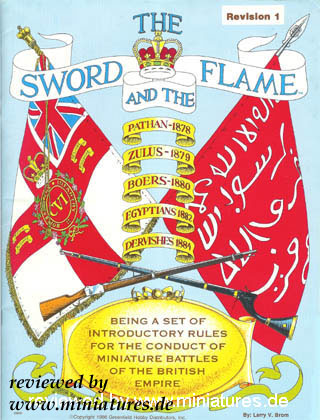
To all those who cherish the poems of Rudyard Kipling, and who think Gunga Din, Four Feathers, and Zulu are among the finest films evers produced, these game rules are respectfully dedicated. With these rules, a light heart, an open mind, and a vivid imagination we will return to the days of the British Empire with the chatter of the Gatlings, the skirl of bagpipes, the Dervish screams, the crack of rifles, and the ring of broadsword on bayonet.
In the latter part of the nineteenth century, the British Victorian Army fought countless frontier wars and border skirmishes against a myriad of worthy foes from the hills of the northwest frontier of India to the scrub-covered plains of the Sudan and South Africa. The Imperial Red (later Khaki) Coats of Her Majesty matched courage, valor, and steel with Zulu, Pathan, Dervish, Egyptian, and Boer for half a century and more.
There were no European-style battles of massed battalions manœuvring in cadenced step, deployed over miles of front and flanked by cavalry and artillery. These were desperate little fights; small groups of rec-coated soldiers and dusky hill tribesmen, sudden volleys and quick rushes with sword and bayonet, a hilltop taken or an attack repulsed, and, finally, the dead and wounded.
Fearless devotion to a cause was universal, and combat was usually to the death. Generally outnumbered, the Imperial forces were usually well-armed, highly disciplined, and superbly led. While their officers and sergeants lived, their staying power in combat was phenomenal. Only rarely did they ever flee the field. Their gallant opponents, from the wily Pathan to the fanatic Dervish, were often severely beaten, but the fight was always hard, and the British ranks somewhat depleted. The frontiers of the Empire were truly, as Kipling said, "bought with the sword and the flame".
Contents
- Title: The Sword and the Flame (TSATF)
- Period: 1850 to 1925 colonial era
- Type: Tactical Skirmish Wargame
- Time Scale: none given
- Ground Scale: none given
- Troop Scale: 1 figure = 3 men
- Basing: single figures
- Author: Larry V. Brom
- Format: 28-page rule book
- Language: English
- Publisher: Yaquinto Publications, Royal Oak, MI
- Published: 1979
Chapters
- Introduction to the Game and the Historical Period
- Day of the Empire, 1 page
- The opposing forces, 3 pages
- Organizing the armies, 2 pages
- The game table, 3 pages
- Acquiring figures
- Painting the armies, 1 page
- Uniform information, 4 pages
- Banners, colours, standards, and flags, 2 pages
- The Game Rules
- Introduction to the game rules, 2 pages
- The sequence of events during each game turn
- The basic unit
- Facing
- Attitude
- Formations, 1 page
- The movement phase, 3 pages
- The fire phase, 2 pages
- The close combat (hand-to-hand) phase, 2 pages
- The morale phase, 1 page
- Supplementary ideas, 2 pages
- Sample Game – The Battle of Chamla Valley, 5 pages
- Epilogue and Further Reference, 3 pages
- Acknowledgement
- Glossary of game and rule terms
- Bibliography
- The Victoria Cross
Quick Reference Charts and Counters
- Close into Combat Chart
- Stand and Fight Chart
- Close Combat Chart
- Morale Chart
- Movement Chart
- Rally Chart
- Firing Chart
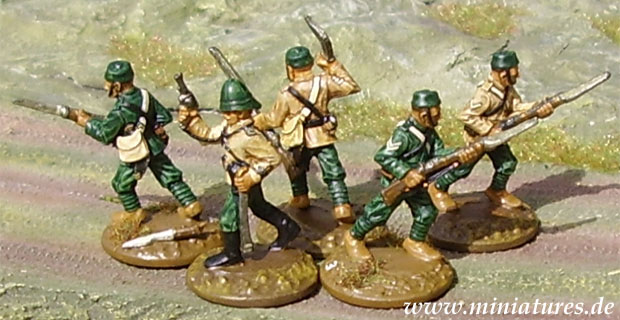
In The Sword and the Flame (TSATF), one Lieutenant, Sergeant, and 18 Privates represent a platoon of European infantry, which may be split into two sections of 10 men each. One Captain, Sergeant-Major, and two platoons represent an infantry company. The colonel and two infantry companies represent an infantry battalion. Tribal opponents are organized into clans or bands of 20 figures, one of whom is the Clan Chief, Amaviyo or Sheik. Three clans and a tribal leader called Hill Chieftain, Induna, or Emir, form a tribe. The photo shows a Lieutenant, Havaldar, Naik, Lance-Naik, and Rifleman of the 5th Gurkha (Rifle) Regiment, wearing a mix of full-dress and campaign dress uniforms.
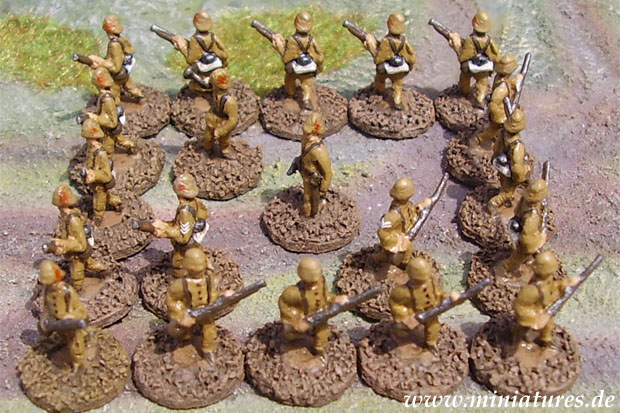
A platoon of the 23rd Royal Welsh Fusiliers deployed in square. If bayonets were fixed, these troops would be ready to repel enemy cavalry. In addition to the Lieutenant and Sergeant, this TSATF platoon has a Corporal and Bugler, who act like regular riflemen in combat. The Fusiliers are antique 15 mm Peter Laing miniatures.
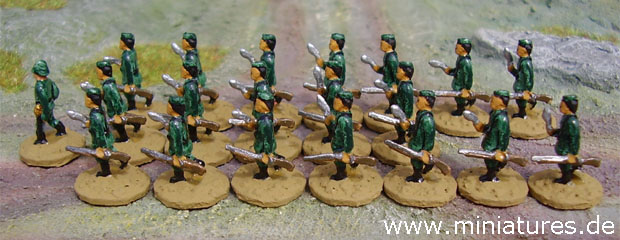
A platoon of the 5th Gurkha (Rifle) Regiment of the Punjab Frontier Force (PFF), or "Piffers". The Gurkhas are advancing in platoon column, with their Lieutenant in the lead, and the Sergeant bringing up the rear. These, too, are antique 15 mm Peter Laing miniatures, painted in full dress uniforms which would gradually be replaced by khaki field service tunics and trousers.
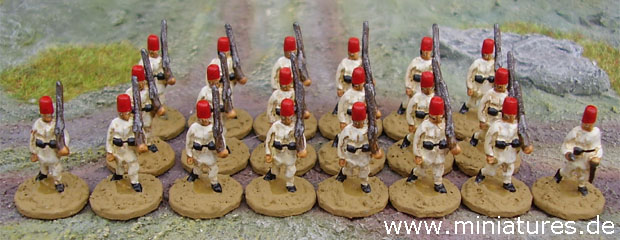
A platoon of Egyptian infantry of the Sudan War, deployed in line. The figures are antique 15 mm Peter Laing miniatures.
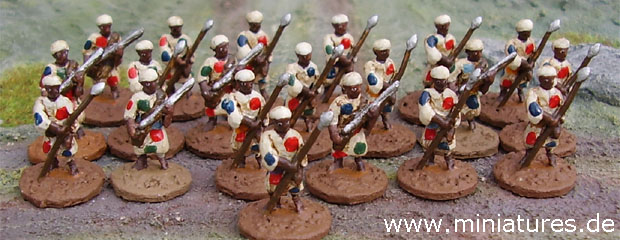
A clan of antique 15 mm Peter Laing miniatures painted as Mahdist warriors of the Sudan War. These warriors are armed with a mixture of spears and rifles.
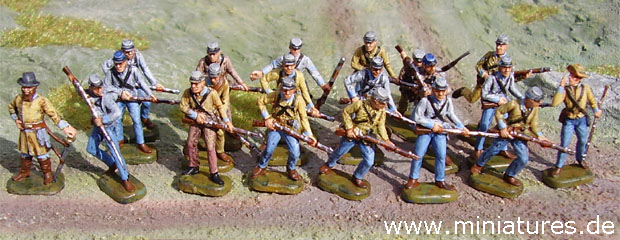
A platoon of 1:72 scale Confederate infantry wearing a mixture of grey and butternut uniforms with sky-blue facings. Not strictly colonial, but these troops may be used in post-ACW games using TSATF rules. Rebel infantry wearing slouch hats may double-up as Boers. The miniatures are ESCI, IMEX, Accurate, and Revell Confederate and Union soldiers, which mix quite well.
While TSATF was designed with the British Victorian Army in mind, the rules are perfectly suitable for other colonial conflicts involving American, Austrian, Belgian, Egyptian, French, German, Italian, Japanese, Russian forces until World War One. Supplemental rules are available which cover the French & Indian War (1754–1763), French Foreign Legion, the Boxer Rebellion (1900), and fighting on boats.